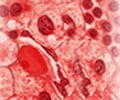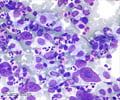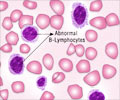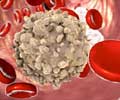AML - Causes
Several factors are indicated in AML but the most prominent causes are the chromosomal abnormalities.
Chromosomal Aberrations: Specific chromosomal abnormalities are found in several patients with AML and they are often associated with prognostic significance.
Risk factors: These factors increase a person's chance of getting a disease.
- Smoking is a proven risk factor for AML. Cancer-causing agents in the tobacco smoke enter the bloodstream and spread to other parts of the body. Smoking causes AML in about 1 in 5 cases.
- Environmental factors that are linked to acute leukemia are:
- Long-term exposure to high levels of benzene or other aromatic organic solvents
- High-dose ionizing radiation exposure also increases the risk.
- People who had earlier undergone chemotherapy are more likely to develop AML within 9 years after treatment. Some of the important anti-cancer drugs that increases the risk for AML are:
- Alkylating agents
- Epipodophyllotoxins
- Anthracyclines
- Very few hereditary causes of acute myeloid leukemia are reported
- The most important risk factor for AML is advancing age.
- Pre-leukemic disorders, such as myelodysplasia or myeloproliferative disorders are important risk factors.
- Individuals with congenital conditions like Down Syndrome(DS) and Fanconi Anemia(FA) have increased risk of developing leukemia. The DS individuals have a 10-18 fold increased chance of developing AML.











